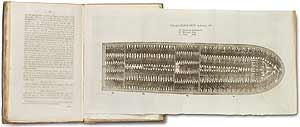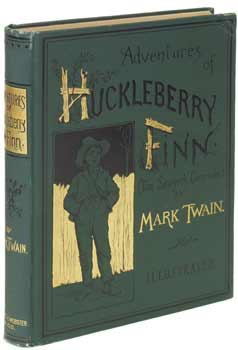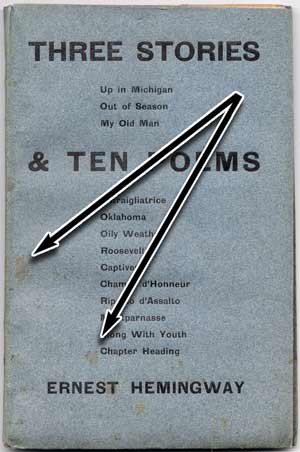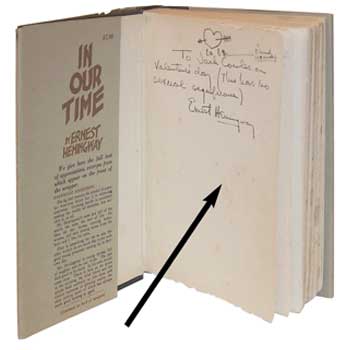
Glossary
What book dealers really mean. Click on thumbnails for larger images.
Facing page
The page opposite the page being referred to.
Figured cloth
A cloth binding decorated with an embossed pattern, such as this copy of Autographs for Freedom, offered in 2006, which contains the first printing of Frederick Douglass' only work of fiction, a novella about a slave mutiny. At least, that's what we figure it means.
Fine
Like, really, really nice man. Trust me... These two first edition copies of Rafael Sabatini's The Sea-Hawk illustrate the difference between fine, on the left, and good, on the right. Guess which one costs more?
Folding plates
Plate, map, or chart that is too big to fit into a book, so it has been carefully folded to fit neatly into the book. Be just as careful when you unfold it, or you may end up with twice the number of plates as you started out with. This 1806 publication on abolition, offered in our Catalog 120, contained a folding-plate of Matthew Carey's famous illustration of the interior of a slave ship.
Follow the flag
Preferring the edition published in the nation of the author's birth. You couldn't find a more classic American novel than Mark Twain's The Adventures of Huckleberry Finn, but it was actually first published in England. However, many collectors prefer to "follow the flag," and the American edition (this fine copy offered in our Catalog 98) is more desirable.
Foot
If you want to know what at Between the Covers is a foot long in measurement, we've got a cheeky answer for you. But you probably want to know what the foot of a book is. The very bottom of the spine of either the book or the dustjacket. The dustjacket of this lovely first edition copy of Stuart Little, offered in our Catalog 113, had a small chip at the foot of the spine. See that? That's the foot.
Foredge
Also called the fore edge, but we believe the "e" has been overused in the English language, and are trying to do our part in conserving them. The front edge of the text block, or the part of the book that is opposite from the spine or bound edge.
Foxing
Spotting on a book, usually brown spots found on paper, of varying severity, caused by a chemical action wherein impurities in the paper oxidize. This is often exacerbated by an excessively humid climate, but the "cause" is the composition of the paper itself, and some books are simply more prone to foxing than others. Of the 300 printed copies of Ernest Hemingway's first book, Three Stories and Ten Poems, such as this copy offered in our Catalog 82, many have foxing. Why are these brown spots called foxing? It could be because the color of the spots reminded someone of the animal, but no one really knows for sure. The term goes back to the 1840s or before, and everyone we've spoken to from that time period has been unusually mum on the subject. Any bookseller or librarian who claims to know the derivation is either making the explanation up on the spot or was duped themselves.
French
Excellent and pretty exhaustive guide to African-Americana poetry: Afro-American Poetry and Drama, 1760-1975: A Guide to Information Sources by William P. French, Michel J. Fabre, Amritjit Singh, and Geneviève E. Fabre. On several occasions we tried to buy Mr. French's own greatly updated copy of this bibliography, which he would coyly suggest might be had, but he inconveniently passed away before we could pry it out of him.
French-folded
Referring to a dustjacket, or the wrappers of a softbound book that have been folded over on all edges.
From English sheets
When the pages used for the American edition of a book that was originally published in England, were imported from England — in effect slapping a new title page and a new binding, with the American publisher's name on it, on the printed pages from the English edition. The sheets of Alice in Wonderland, after being rejected as inferior by Lewis Carroll, were shipped to America, and when thus fitted out, they became the first American edition "from English sheets."
Front fly
The first moveable leaf of paper in a book, often blank, which is usually attached to the front pastedown. Also called the front free endpaper, the fly leaf, or the fly. Ernest Heminway inscribed this first edition of In Our Time (offered in our second Classic Book Cards set) on the front fly. Since he inscribed it on Valentine's Day he drew a heart with an arrow. Since he was Ernest Hemingway and the recipient was a favorite drinking buddy, he further noted: "This has no sexual significance." Whatever you say, Papa.
Front Panel
See Panel, and do your utmost to put the information in context.







